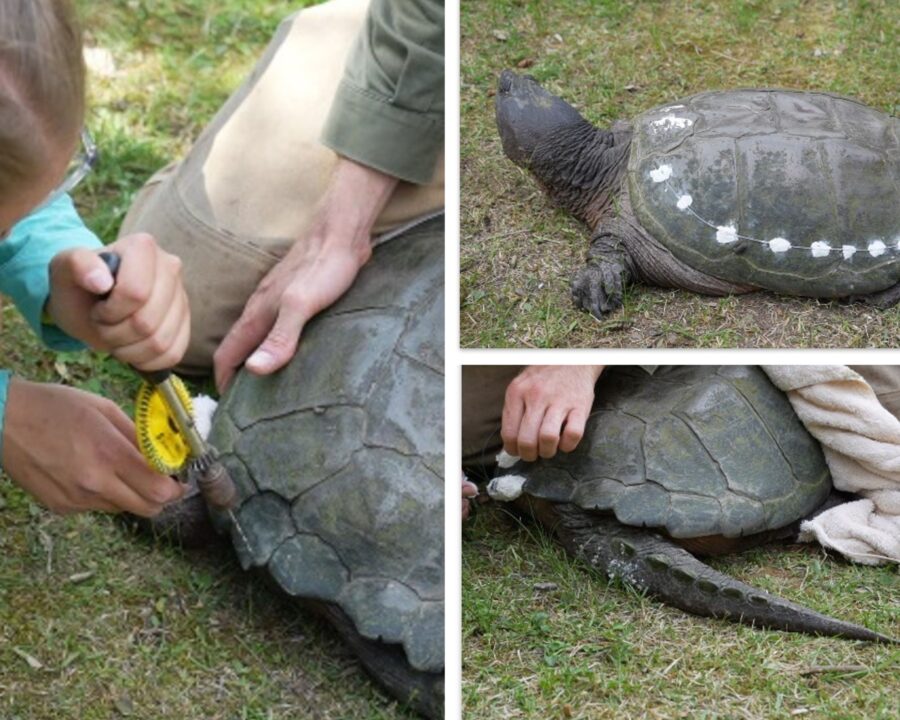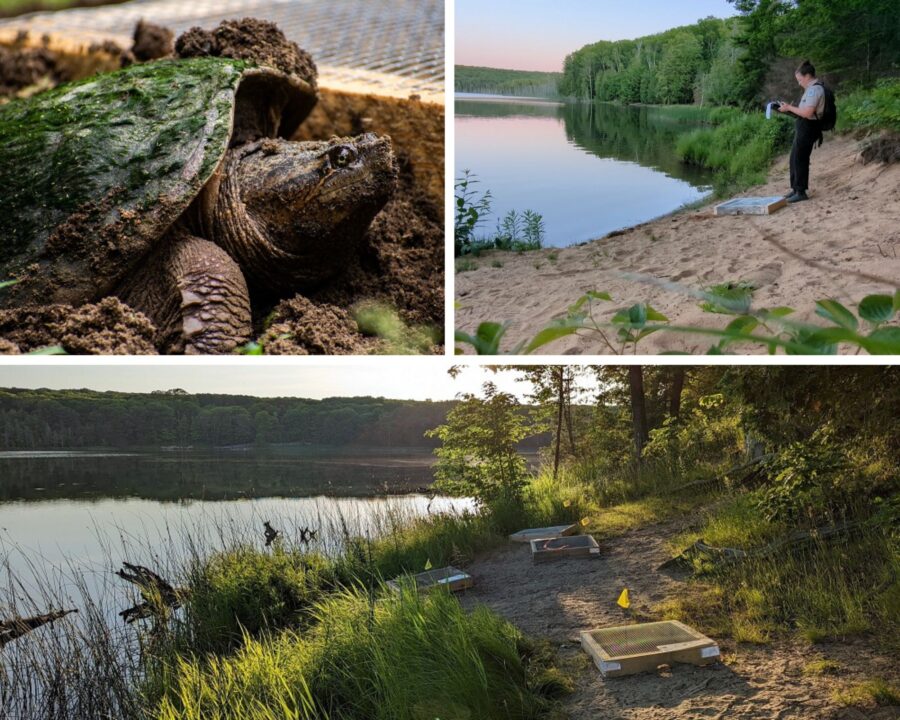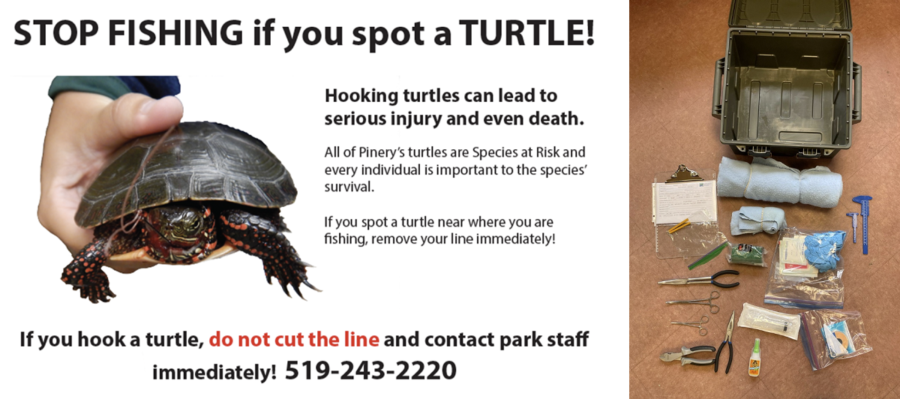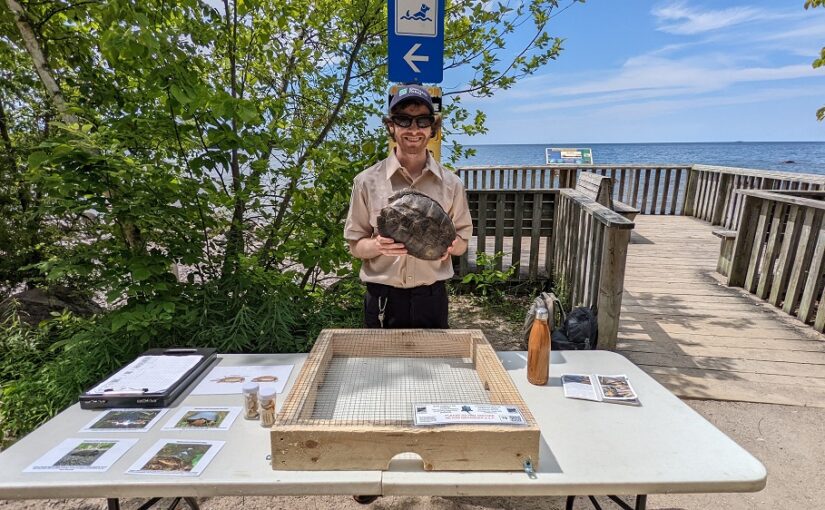We’ve got some “egg-citing” news!
In 2022, we went on a mission to protect Ontario’s at-risk turtles.
It was a huge success! In fact, at one park, we had our first Painted Turtle hatchling emerge from a nest in ten years!
And it wouldn’t have been possible without our “turtley” awesome donors and the Turtle Protection Project.
Mission #1: sending Henry on an undercover spy mission
Knowing how turtles use our parks helps us better protect them.
Meet Henry. Our inside man.

Staff at Algonquin outfitted Henry, a Common Snapping Turtle, with a radio telemetry device with two years of battery life to track and locate his movements.
And it turns out that Henry spent his entire summer within a few hundred meters of the docks, often seen looking for food!
It’s common to see food thrown into the water at campsites and beaches at Algonquin, which is why Henry was drawn there.
Reminder: feeding wildlife is harmful. It:
- makes them dependent on humans for food
- attracts them to hang out near dangerous places (like busy roads or docks!)
- can cause serious illness or death
Your donations let us learn a lot from Henry, even in a single summer.
Our Discovery staff are also teaming up with Henry to show visitors:
- how the transmitter works
- why it’s so critical not to feed wildlife
The Algonquin team will continue to collect data on Henry and deploy two other radio tags in the future.
Mission #2: helping baby turtles cross the road to live beyond their teenage years
Did you know Mama Snapping Turtles might travel as much as 8 km — one way! — to find the perfect spot to lay their eggs?
And then the tiny hatchlings need to find their way to water.
A busy park like Pinery has 100 km of roads and other human-made obstacles for the turtles to cross.
And all too many turtles don’t make it safely to the other side.

We wanted to help more Pinery turtles live long enough to grow up.
Donations to our Turtle Protection Project helped us:
- install a digital speed feedback radar at a road mortality hotspot
- adding a sign indicating the likelihood of animals on the road, which points to “extreme” during turtle nesting and hatching season
- delivering “Why did the Turtle Cross the Road?”, an Ask-the-Naturalist program to educate park visitors on how they can help keep turtles safe
Thanks to our park staff, community scientists, and donors, zero hatchlings were struck on the road last year!
What an extraordinary result, given that most nests hatched during the park’s peak visitation period.
Mission #3: preventing turtle eggs from turning into a tasty snack

Did you know raccoons and foxes dig up turtle nests and eat the eggs?
And in campgrounds with a lot of people, you’ll know how common those predators are!
When garbage is left behind, raccoon and fox populations go way up.
This increase can lead to egg predation rates of over 99% in heavily affected areas. Egg predation is when an animal (a predator) hunts for and eats the eggs of another (prey) species.
To keep nests safe from predators, we:
- installed nest protectors on detected nests
- conducted nesting surveys to find more nests to protect
Thanks to the surveys, the park protected 46 nests (a record number!).
Our park staff worked day and night in all weather conditions to protect Balsam Lake’s turtle nests.
Thanks to support from the Turtle Protection Project, Balsam Lake had its first Painted Turtle hatchling in ten years!

It emerged in the fall of 2022 from an artificial nesting area built, monitored, and protected by volunteers and staff.
Mission #4: keeping turtles off the hook
No one tries to hook a turtle, but fishing can be hard on our shelled buddies.
Sometimes, turtles swallow fishing hooks and lures because they think it would be a tasty snack.
When turtles swallow hooks, it is often fatal.
Especially if anglers cut the line, it can prevent the turtle from receiving care for potentially life-threatening wounds.

We worked hard to keep turtles off the hook at Pinery by:
- installing signs at fishing docks to educate anglers
- launching creative angling stewardship programs, including our Hook Exchange and Worms for Popsicles programs
- creating “Turtle Trauma Kits” to enable a faster response to injured turtles in the park
With the sustained support of the Turtle Protection Project, we can all work together to keep turtles off the hook!
Not in the park? You can still help!
Wherever you are in the world, you can help us protect turtles.
Check out the Turtle Protection Collection in our online store. Proceeds from these sales directly support these projects.
Donate directly to the Turtle Protection Project. Your donation will be used to fund even more turtle research and protection projects.

